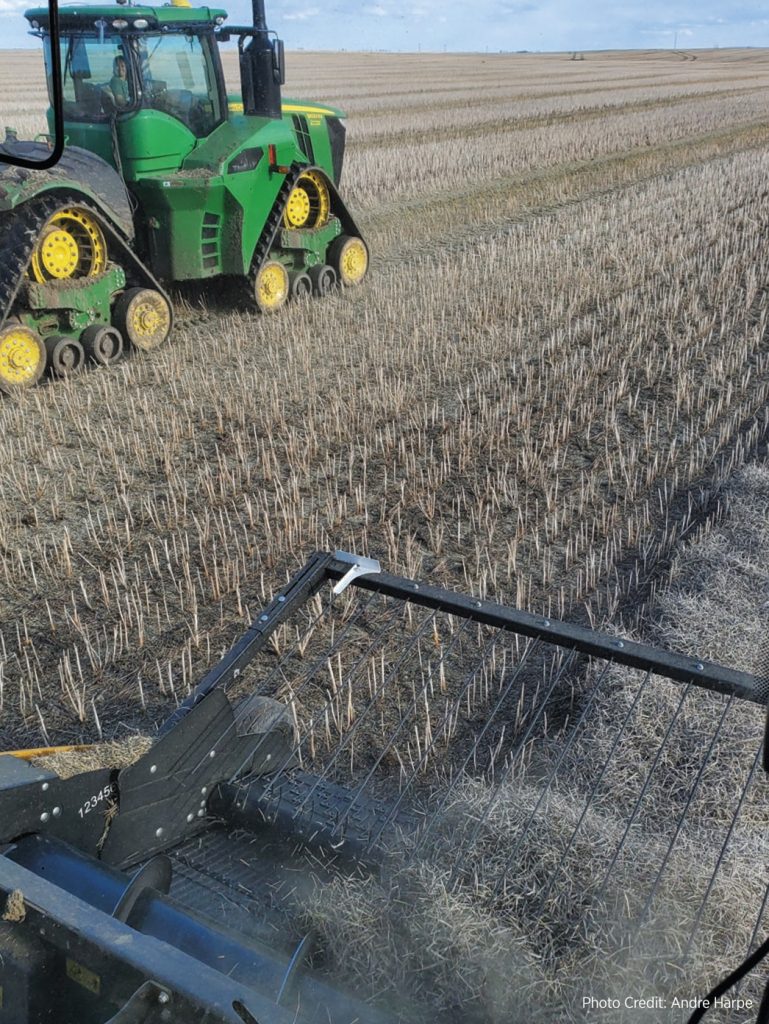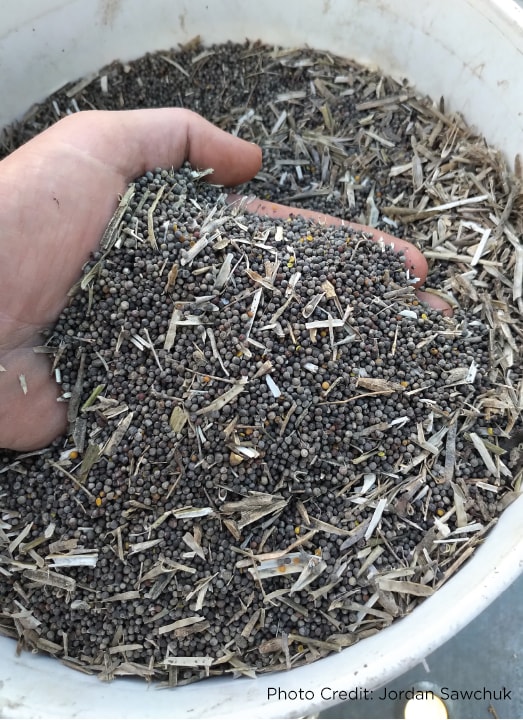What I learned from Harvest 2019–20
From the Peace Country of northern Alberta all the way down to southern Manitoba, many Prairie canola producers agree that fall 2019 was one of the worst harvest seasons on record. Several found themselves trying to salvage what canola they could well into the spring. Quality, yield and ease-of-harvest for this spring-harvested canola depended highly on circumstances.
Andre Harpe’s 2019–20 canola story had many of the makings of a disaster, but a little luck – and a lot of sweat – turned his spring-harvested canola into a relative success.
Plentiful moisture throughout summer 2019 initially bode well for the Valhalla Centre, Alberta canola and barley producer. But those conditions quickly turned into too much of a good thing.
“Throughout the summer and going into the fall we had what was rapidly becoming a bumper crop,” says Harpe. “The conditions that led to the crop being very good unfortunately never quit.”
“Ninety per cent of my canola graded at number one.” However, he still lost a sizeable portion of his crop. “I probably lost a quarter to a third of the crop just through shelling and disappearing through normal wear and tear on the pods.
Sometime around October 24 his area was blanketed by a heavy, wet snowfall which dashed his hopes for a fall harvest.
Although his crop insurance provider wrote off his unharvested barley, it didn’t extend the same offer for his canola. “They really encouraged us to try harvesting it before we wrote it off.”
When the snow finally melted late in the spring, Harpe was pleased to discover that the snow had served as protective cover for his canola crop.
“One of our saving graces was the snow never left us,” he says. “It never went through freeze-thaws. The canola wasn’t exposed to air until April. I think what happened is none of the moulds that usually set in had that opportunity. Scientifically I can’t prove it, but I think it helped.”
Harpe wasn’t able to apply combine canola until April 29, just as it was time to plant a new crop. What followed was a “logistical nightmare” full of wet, 16-hour days.
“Half of my (unharvested) crop was swathed and half of it had been left standing. The swathed canola was fairly easy to pick up and went fairly fast,” Harpe says. “The standing stuff was so low and flat that it was extremely slow and difficult to pick up.”
The canola Harpe was able to salvage did quite well. “The canola – for the most part – was in very good condition. Ninety per cent of my canola graded at number one.”

However, he still lost a sizeable portion of his crop. “I probably lost a quarter to a third of the crop just through shelling and disappearing through normal wear and tear on the pods.”
Because there were so many circumstances beyond his control, Harpe says he doesn’t plan to do anything different in harvest 2020.
“Last year was a very abnormal year and typically we do get a few good weeks of harvesting weather. I don’t expect to see such conditions (as last year) happening again and I’m hoping they won’t happen for quite a while.”
A Manitoba experience
Jordan Sawchuk is no stranger to abundant rain and snow, early winters, late falls and few growing degree days on his mixed farm in the southern Manitoba community of Mountain Road.
“It showed us some vulnerabilities that we have as an operation.
We learned that our combines will combine very wet grain; we just need the ability to deal with that wet grain.”
But the fall, winter and spring of 2019-20 proved almost insurmountable – even for this veteran. With excessive moisture starting in mid-August and continuing on through the winter, he and his workforce pushed themselves and his equipment through 24-hour days to get off what they could. Ultimately, 1,000 acres of canola and about 400 acres of wheat were left on the ground over winter – a sum representing half of his total crop.

Still, he considers himself lucky compared to some of his neighbours. “We didn’t have a great harvest, but a lot of guys didn’t even get started in our area, and by that I mean their combines didn’t even leave the yard.”
When the land dried up enough to attempt harvest in the spring, Sawchuk had some tough decisions to make. Lacking the manpower and trucks to harvest and plant at the same time – not to mention fears of cross-contaminating harvested seed with fertilizer and treated seed – he decided to combine as much as he reasonably could before planting a new crop.
Starting May 7 and running for six days, he and his crew jumped from field to field attempting to harvest the driest areas. “We ended up having to burn what we were unable to harvest,” he says.
Much of his crop remains in storage with plans to sell, but Sawchuk isn’t expecting to get much out of it. “It was very high dockage, going by the samples we sent to the elevator. I don’t even know what they graded it.”
Sawchuk doesn’t think there was much he could have done differently to turn his luck around last fall. However, he refuses to complain, opting instead to take the ordeal of 2019–20 as a learning experience.
“It showed us some vulnerabilities that we have as an operation,” he says. “We learned that our combines will combine very wet grain; we just need the ability to deal with that wet grain.”
For Sawchuk, that means higher drying capacity. Although he hasn’t figured out all the details at this point, he knows he wants a high-throughput drying system, large wet bins and the ability to move canola and grain to multiple bins using limited manpower on a 24-hour schedule.
“We’re looking at a system approach,” he says.
“You always have to step back and look at things and you have to learn. Can I prevent Mother Nature from dumping six to 10 inches of rain on us?” he says, referring to a recent weather event at the time of interview. “No I certainly can’t. But maybe there are things we can do.”






